-
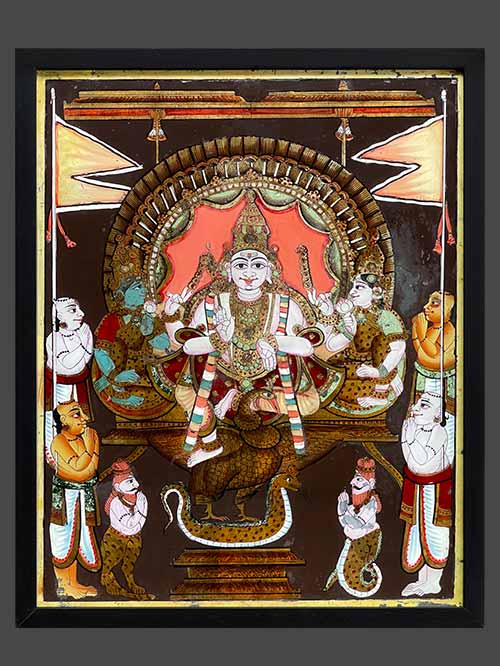
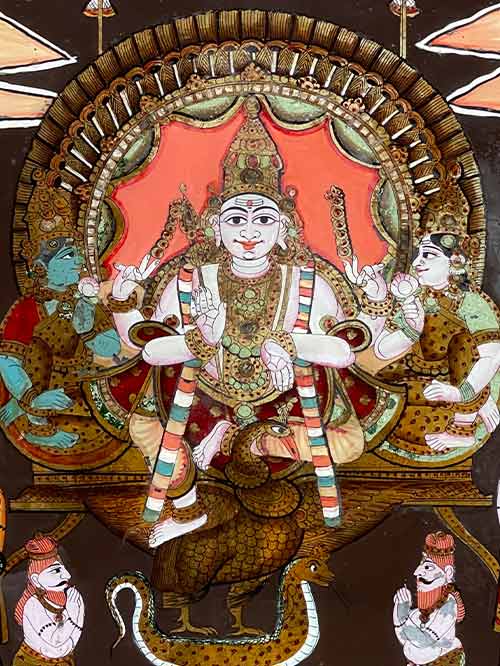
Tanjore (South India)
reverse painting on glass
Kartikeya (also known as Subrahmanyam, Murugan or Skanda) sits on a throne held up by his conveyance, the peacock. His consorts, the fair Devasena on his left and the blue-complexioned Valli on his right, are seated by his side. The realistically rendered tail of the peacock frames the trio and doubles as a ritual prabhavali. The peacock stands majestically with its talons firmly planted on a cobra. Set against a brown background, flags define the sides of the painting where four Brahmin devotees pay homage to the divine group along with the sages Patanjali on the right and Vyaghrapada on the left.
Reverse glass paintings were introduced into India the late 18th century from China by way of the China Trade. Indian artists adopted the technique of reverse glass painting partly on account of its novelty and also because it was a relatively inexpensive medium which could produce rich effects. The technique proved extremely popular and soon spread through western and southern India and even to former provincial Mughal capitals of Oudh, Murshidabad.
In Tanjore – a small state with an old art tradition- a distinctive school of glass painting developed in the early 19th century and continued for more than a hundred years. The style was essential Indian – it tended to repeat patterns of regional painting: images of deities, portraits and themes form the ancient myths, secular themes such as portraits of kings or nobles, courtesans and musicians. The colour was rich and the style bold and defiant. The subjects were clearly presented with a certain opulence and glamour.
Painting Size (cms): 50(H) x 40(W)
Painting Size (inches): 19.75(H) x 15.75(W)
Framed Size (cms): 54(H) x 44(W) x 4(D)
Framed Size (inches): 21.5(H) x 17.5(W) x 1.5(D)
-

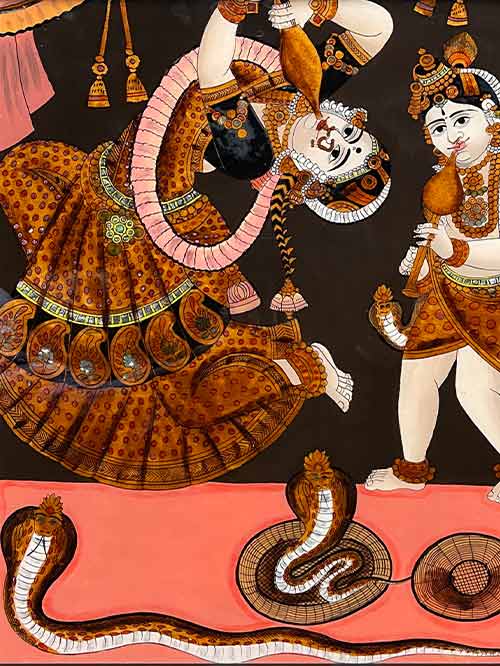
Tanjore (South India)
reverse painting on glass
A charming reverse glass painting depicting a Krishna and Yashoda as snake charmers each hypnotising a cobra with the melodic sounds of their fluted instruments called pungis. The adolescent Krishna is bejewelled and splendidly clad in a lower garment with a hip-hugging sash and a garland of flowers around his neck. His foster-mother Yashoda who is also gorgeously robed and jewelled contorts around to befuddle the snakes.
Reverse glass paintings were introduced into India the late 18th century from China by way of the China Trade. Indian artists adopted the technique of reverse glass painting partly on account of its novelty and also because it was a relatively inexpensive medium which could produce rich effects. The technique proved extremely popular and soon spread through western and southern India and even to former provincial Mughal capitals of Oudh, Murshidabad.
In Tanjore – a small state with an old art tradition- a distinctive school of glass painting developed in the early 19th century and continued for more than a hundred years. The style was essential Indian – it tended to repeat patterns of regional painting: images of deities, portraits and themes form the ancient myths, secular themes such as portraits of kings or nobles, courtesans and musicians. The colour was rich and the style bold and defiant. The subjects were clearly presented with a certain opulence and glamour.
Painting Size(cms): 47 (H) x 43.2 (W)
Painting Size(inch): 18.5 (H) x 17 (W)
Framed Size (cms): 49.5(H) x 46(W)
Framed Size (inches): 19.5(H) x 18(W)
-
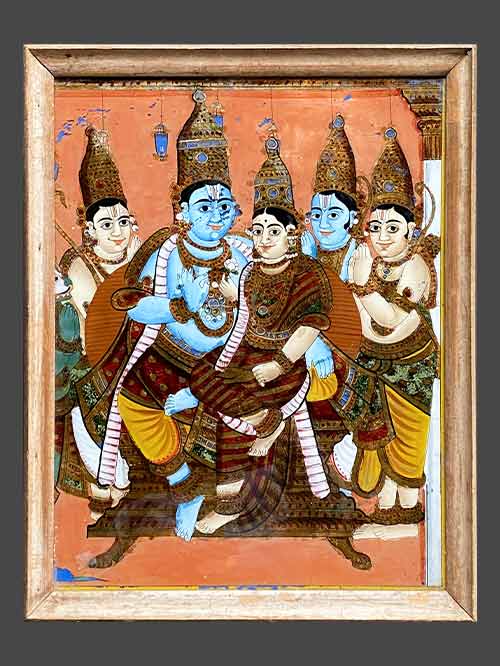
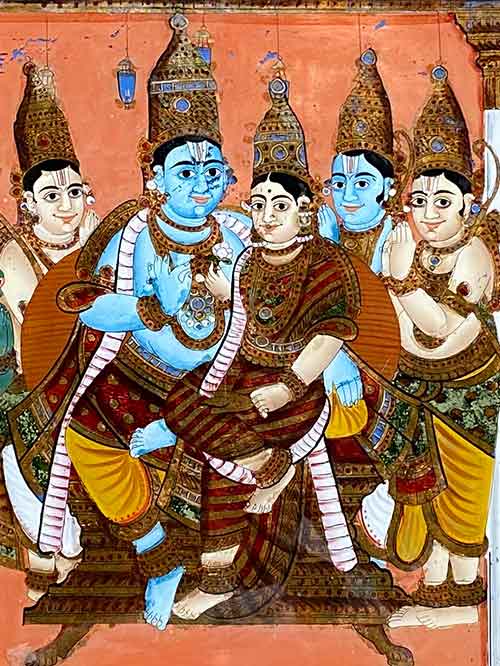
Tanjore (South India)
reverse painting on glass
The central group consists of Rama seated in lalitasana on a gilded throne with Sita on his lap. Lakshmana stands immediately behind him to the left; a blue-complexioned Bharata and Shatrugna stand behind Sita on the right. Rama, the hero of the Hindu epic Ramayana, was a king of Ayodhya and is regarded as an ideal ruler and a paragon of virtue. He is considered an avatar of Lord Vishnu. Rama’s journey portrays his unwavering devotion to his wife Sita and his ultimate triumph over the demon king Ravana.
Reverse glass paintings were introduced into India the late 18th century from China by way of the China Trade. Indian artists adopted the technique of reverse glass painting partly on account of its novelty and also because it was a relatively inexpensive medium which could produce rich effects. The technique proved extremely popular and soon spread through western and southern India and even to former provincial Mughal capitals of Oudh, Murshidabad.
In Tanjore – a small state with an old art tradition- a distinctive school of glass painting developed in the early 19th century and continued for more than a hundred years. The style was essential Indian – it tended to repeat patterns of regional painting: images of deities, portraits and themes form the ancient myths, secular themes such as portraits of kings or nobles, courtesans and musicians. The colour was rich and the style bold and defiant. The subjects were clearly presented with a certain opulence and glamour.
Framed Size (cms): 48.25(H) x 38(W)
Framed Size (inches): 19(H) x 15(W)
-
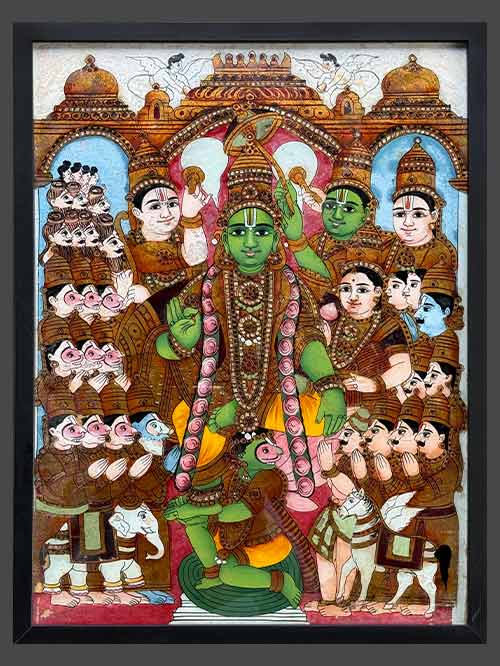
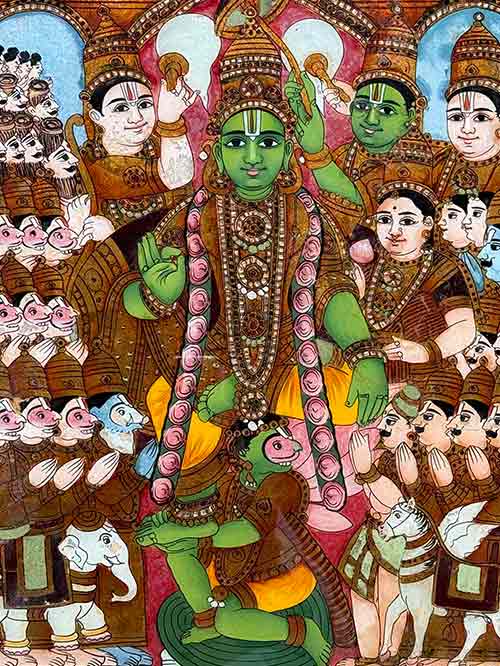
Tanjore (South India)
reverse painting on glass
Rama’s coronation, Ramapattabhisheka, is one of the most popular themes of South Indian painting. The central group consists of Rama seated in lalitasana on the throne with Sita to his left; Lakshmana carrying a chamara (fly whisk) standing immediately behind him; a green-complexioned Bharata carrying a parasol standing behind Sita; Shatrugna with a fly whisk to Bharata’s left and finally, in the foreground, Hanuman lovingly supporting Rama’s right foot. On either side are groups of attendees. The group on the left consist of ascetics, the monkeys and Jambavan — here recognisable by his blue snout. On the right are a number of courtly figures. Among them should be Vibhishana, the new king of Lanka, who helped Rama in defeating Ravana, but not readily recognisable here.
Reverse glass paintings were introduced into India the late 18th century from China by way of the China Trade. Indian artists adopted the technique of reverse glass painting partly on account of its novelty and also because it was a relatively inexpensive medium which could produce rich effects. The technique proved extremely popular and soon spread through western and southern India and even to former provincial Mughal capitals of Oudh, Murshidabad.
In Tanjore – a small state with an old art tradition- a distinctive school of glass painting developed in the early 19th century and continued for more than a hundred years. The style was essential Indian – it tended to repeat patterns of regional painting: images of deities, portraits and themes form the ancient myths, secular themes such as portraits of kings or nobles, courtesans and musicians. The colour was rich and the style bold and defiant. The subjects were clearly presented with a certain opulence and glamour.
Framed Size (cms): 64(H) x 49(W)
Framed Size (inches): 25.25(H) x 19.25(W)
-
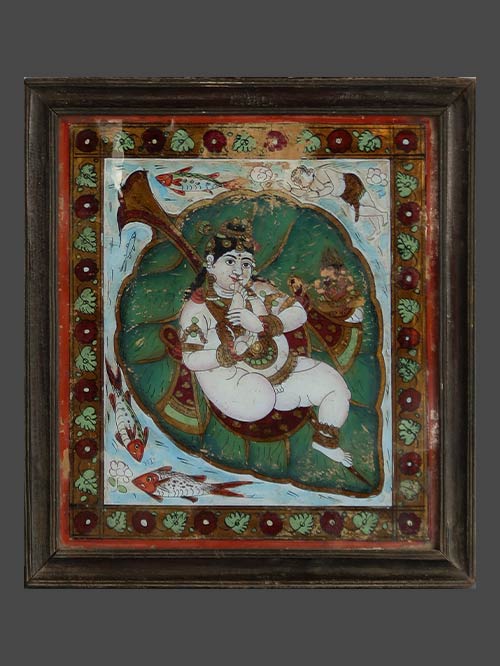
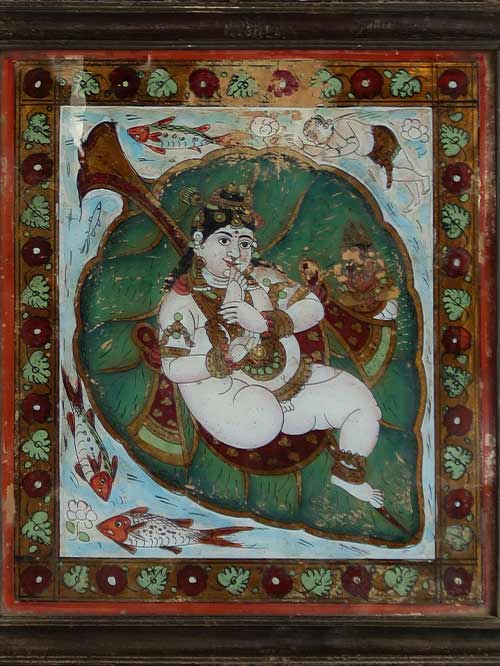
Tanjore (South India)
reverse painting on glass
Krishna as a child lies on a giant banyan leaf content, innocent, with a hint of amusement on his face. Naked but for his jewellery and a draped angavastra, he is depicted sucking his raised toe. As always, he is shown as a chubby child. The leaf he rests on is encircled by a school of fish, swimming amidst the primordial waters. Depicted on the top right is the sage Markandeya reaching out for the safety of the banyan leaf. A diminutive Brahma hovers above Krishna’s left foot. A border of leaves and roundels frames the scene.
The story of Krishna as Vatapatrasayi, or the Lord of the Banyan Leaf, occurs during the end of the world when the sage Markandeya sees the destruction caused by the great flood. In the midst of the chaos, he sees a small child floating on a banyan leaf, sucking his raised toe. Markandeya is drawn into the child’s body where he discovers the entire world, with all its realms, contained within the child who is oblivious to the disaster happening outside. The sage then realises that the child is a god who has taken the world into himself before recreating the universe.
Reverse glass paintings were introduced into India the late 18th century from China by way of the China Trade. Indian artists adopted the technique of reverse glass painting partly on account of its novelty and also because it was a relatively inexpensive medium which could produce rich effects. The technique proved extremely popular and soon spread through western and southern India and even to former provincial Mughal capitals of Oudh, Murshidabad. In Tanjore a distinctive school of glass painting developed, with a rich colour and bold and defiant style. The subjects were clearly presented with a certain opulence and glamour.
Framed Size (cms): 46.5(H) x 41.5(W)
Framed Size (inches): 18.5(H) x 16.5(W)
Painting Size (cms):39.5(H) x 31.5(W)
Painting Size (inches):15.5(H) x 12.5(W)
-

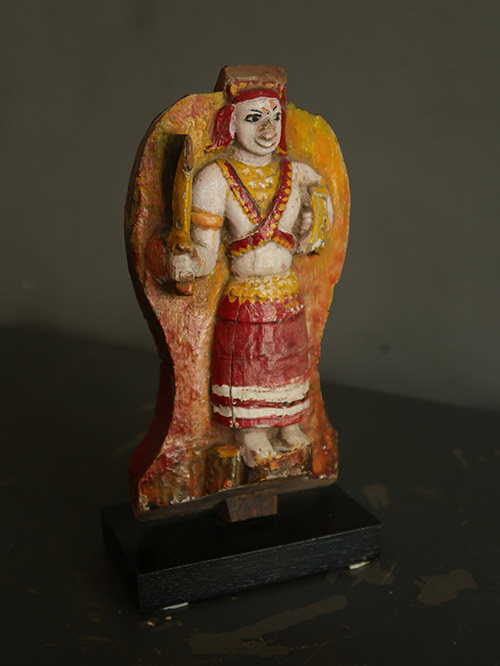
Northern Kerala (South India)
polychromed Wood
A finely carved panel depicting Karim Kutty Sasthan.
Karim Kutty Sasthan is one of the five so-called “magical” deities. He is a deity whose ambiguous and complex myth describes him as the unruly son of a Brahmin exorcist. After his father savagely beats him for sacrificing a favourite red bull, the boy leaves home and goes on a bloodthirsty rampage. Despite this seemingly ungodly behaviour, he is a mysterious god of tremendous powers possessing the attributes of both Lord Shiva and Lord Vishnu.
Theyyam is the ancient Malabar performance-ritual in which empowered men, after suitable mental, physical and spiritual preparations ‘become’ the deities. Wearing spectacular costumes and headdresses and with their human features hidden behind mask-like make-up, they enter the shrine’s precincts to make the final transference from one state of consciousness to another. The defining moment comes when they gaze into a mirror and see not their own made-up face but a reflection of the deity. Once this line has been crossed, devotees can directly approach, honour and question a deity belonging to an extraordinary pantheon of divine beings, consisting not only of gods and goddesses but deified ancestors, warrior heroes, animals, ghosts and spirits.
Size(cms): 26.5 (H) x 13,5 (W)
Size(inches): 10.5 (H) x 5 (W)
-
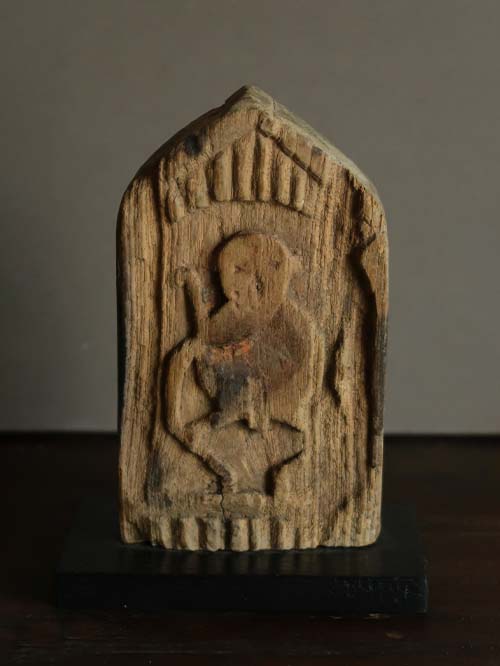
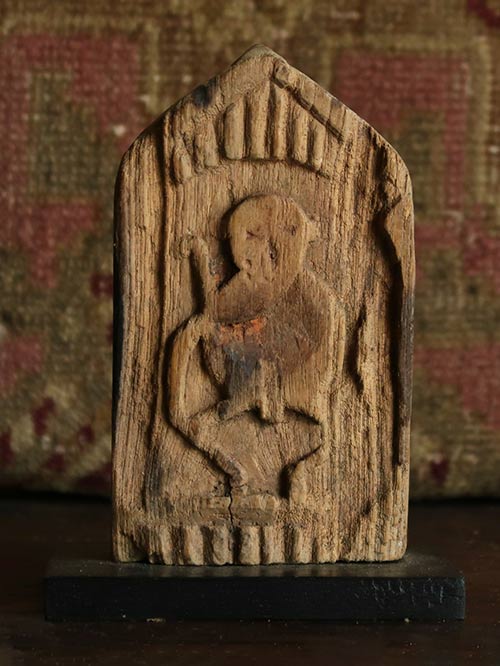
Western India
Wood
A primitive door panel with a central figure of a two-armed Ganesha. An arch frames the central figure forming a ritual throne around the deity.
Size(cms): 13.5 (H) x 10 (W) x 6.5 (D)
Size(inches): 5.3 (H) x 4 (W) x 2.5 (D)
-
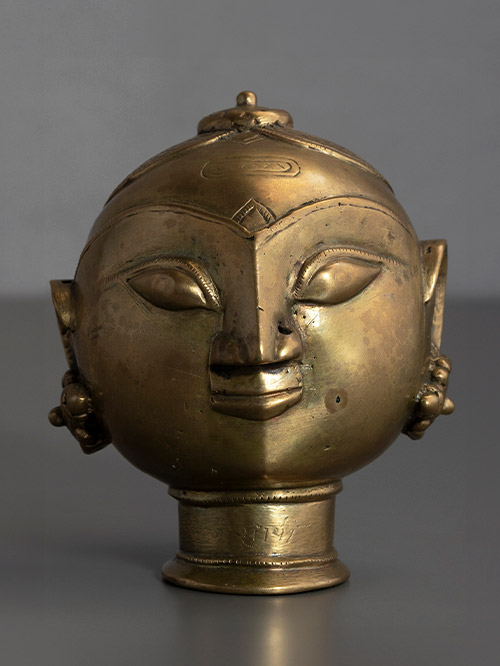
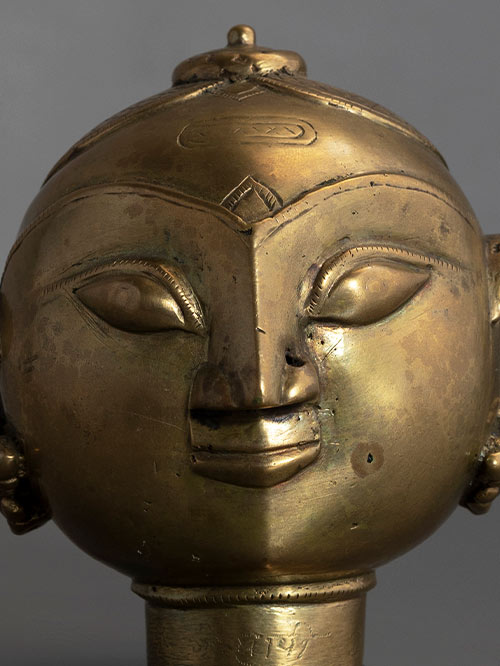
Maharashtra/ Karnataka
Brass alloy
Gauri is the name of a benevolent goddess, consort of Shiva or Varuna. Connected with the rains, she is reputed to be the source of the world and the embodiment of motherhood. She is depicted as a two-or four-armed woman of fair complexion, carrying in her upper arms prayer beads and a water pot, while the lower hands are in Abhaya and Varadamudra. She may also carry a mirror, a fish, a lotus, a trident and a floral wreath. Her mount is the godhika (iguana). Occasionally she is shown riding either a lion, a wolf, a pig or a goose.
Size (cms): 12(H) x 10(W) x 10(D)
Size (inches): 4.5(H) x 4(W) x 4(D)
-
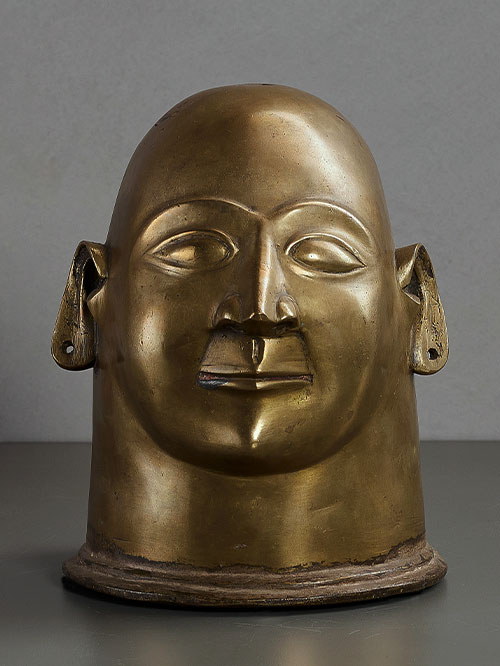

Karnataka (South India)
Brass alloy
A very unusual Gauri head with large almond shaped eyes, pierced ears and a smooth rounded head.
Gauri is the name of a benevolent goddess, consort of Shiva or Varuna. Connected with the rains, she is reputed to be the source of the world and the embodiment of motherhood. She is depicted as a two-or four-armed woman of fair complexion, carrying in her upper arms prayer beads and a water pot, while the lower hands are in Abhaya and Varadamudra. She may also carry a mirror, a fish, a lotus, a trident and a floral wreath. Her mount is the godhika (iguana). Occasionally she is shown riding either a lion, a wolf, a pig or a goose.
Size (cms): 26.75(H) x 22.8(W) x 20.3(D)
Size (inches): 10.5(H) x 9(W) x 8(D)
-
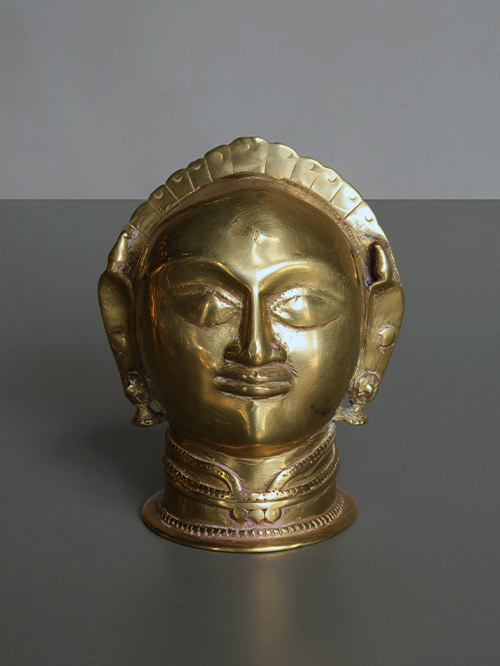
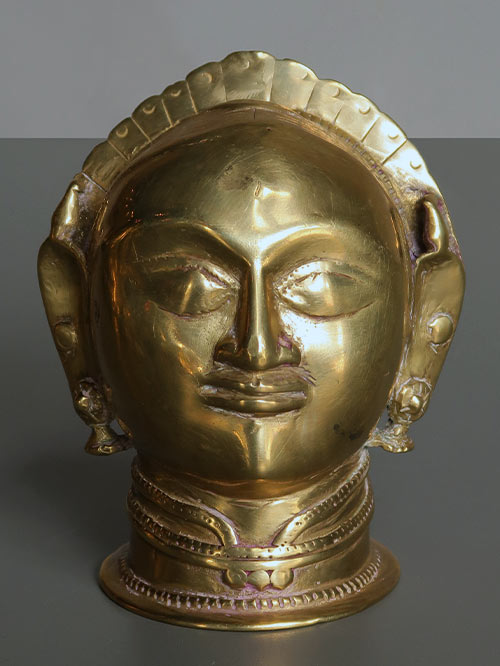
Maharashtra/Karnataka
Brass
An attractive diminutive Gauri head with finely modelled features including necklaces, hair and ear ornaments as well as an engraved crown. Gauri is the name of a benevolent goddess, consort of Shiva or Varuna. Connected with the rains, she is reputed to be the source of the world and the embodiment of motherhood.
In household shrines in Maharashtra and Karnataka, the deity was considered a privileged house guest and treated accordingly. Images of the god were bathed, clothed, bejeweled and nourished in preparation for puja and darshan. Often elaborate turbans were placed on the head and bound by the finest cloths usually in the auspicious deep red colour. In some cases the masks were mounted on a wooden framework and covered with cloths. Sometimes separate metal cast arms and legs were attached to the figure, thus providing a more realistic depiction of the deity.
Size (cms): 12(H) x 9(W) x 8(D)
Size (inches): 4.5(H) x 3.5(W) x 3(D)
-
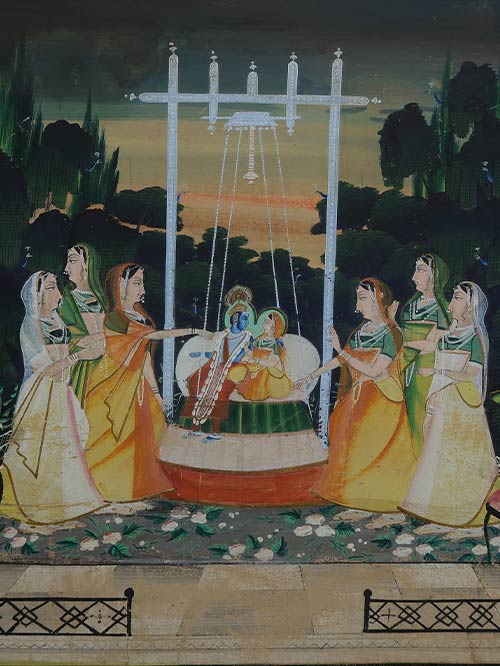
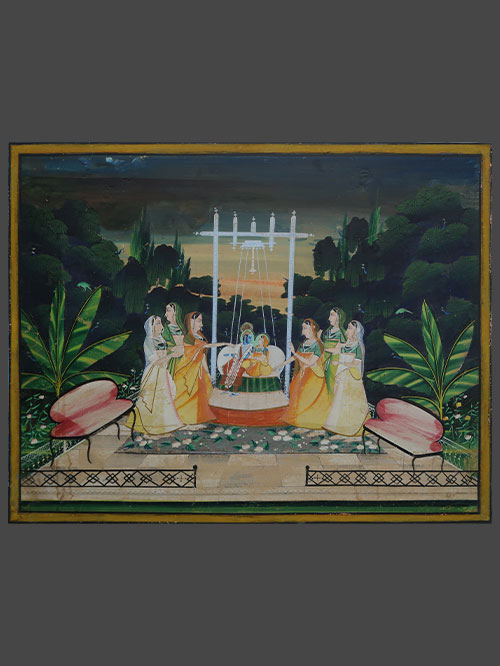
Nathdwara (Rajasthan)
opaque watercolour and gold on paper
Krishna and Radha sit resting against a large white bolster on an ornate silver swing. Underfoot is a floral decorated carpet on a chequered marble floor with iron balustrades. Six female attendants flank the nimbate couple whose gazes are firmly fixed on each other. In the foreground are a pair of European style pink settees while in the distance an orange hued sky indicates the setting sun. Dense clusters of trees and foliage sprinkled with parrots and peacocks envelope the central scene.
Such large and dramatic scenes were painted by Nathdwara artists who produced these images for devotees who visited the great Krishna temple at Nathdwara in Rajasthan. Founded in the 17th century, this temple has attracted an enormous following even to this day, in turn ensuring a continuing tradition of devotional images. The extravagant size and conception of these paintings remind one of the constant importance of religious images in India, not only as ritual objects but also items for pilgrims to acquire and bring home from the great Hindu shrines.
Towards the end of the nineteenth century and early twentieth century Nathdwara artists were exposed for the first time to European art prints whose influence can be seen in the paintings of this period.
Size Painting (cms): 44.5 (H) x 57 (W)
Size Painting (inch): 17.5 (H) x 22.4 (L)
-
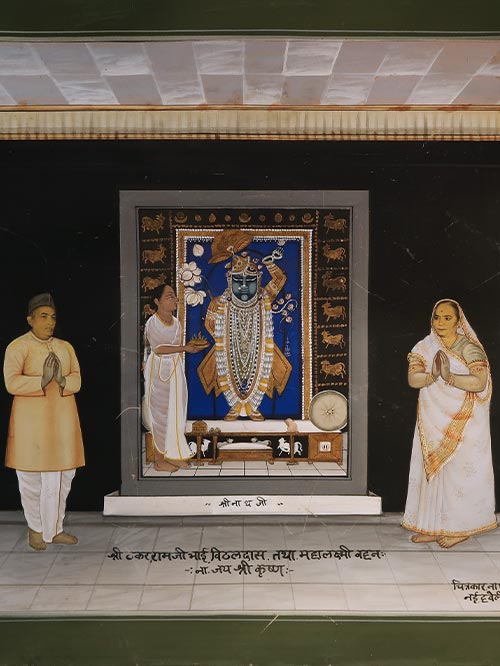
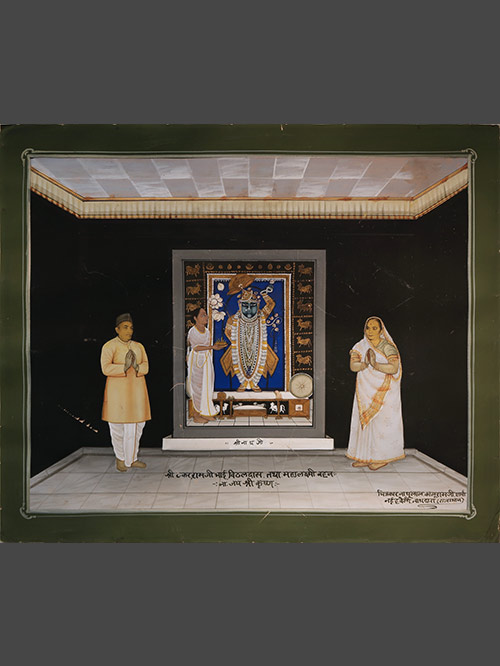
Nathdwara (Rajasthan)
Opaque watercolour, gold and gelatin silver print on paper
Inscribed on recto ‘Nathulal Kaluramji Sharma, Nathdwara’
In Pushti Marga terminology, to perform a manoratha is to offer a seva ( ritualistic service) to the deity in fulfilment of a long cherished inner yearning to serve him in a special way on a particular day. Only a few select Goswamis, direct descendants of Vallbhacharya, are given this privilege and every Goswami longs to perform a manoratha at least once in a lifetime. A wealthy devotee can also perform a manoratha on an important day of his life or in the fulfilment of a vow. This is done by contributing towards the expenses of a particular darshana ( formal viewing of a deity) or by paying for the seva of an entire day. To commemorate this event, devotees usually commission a painting showing them on both sides of Srinathji outside the threshed of the sanctum. In the present painting actual photographs of the donors faces are incorporated into the painting. This served as a visual record of their worship before the famed icon.
Sri-Nathji ( The Lord of Shri, Goddess of Wealth) enshrined at Nathdwara is the most important svarupa (own form) in the Pushti Marga, and represents Krishna at the age of seven. Sri-Nathji is Krishna incarnate, the tutelary deity of the Vallabhacharya whose swarupa or image is enshrined at Nathdwara.
Painting Size (cms): 50.5 (H) x 60.5 (L)
Painting Size (inch): 19.9 (H) x 23.8 (L)
-
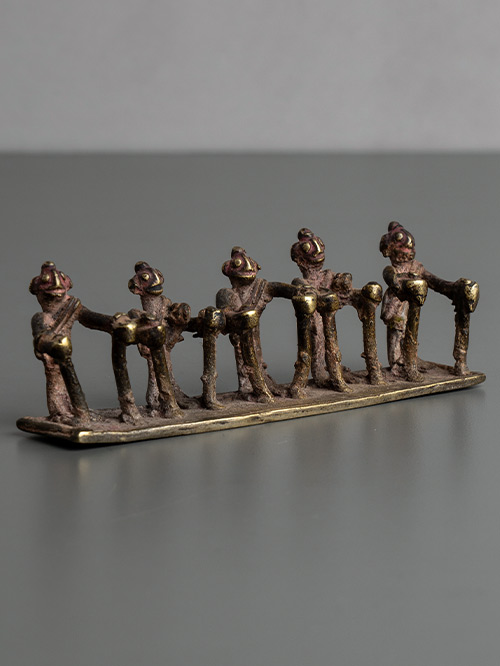
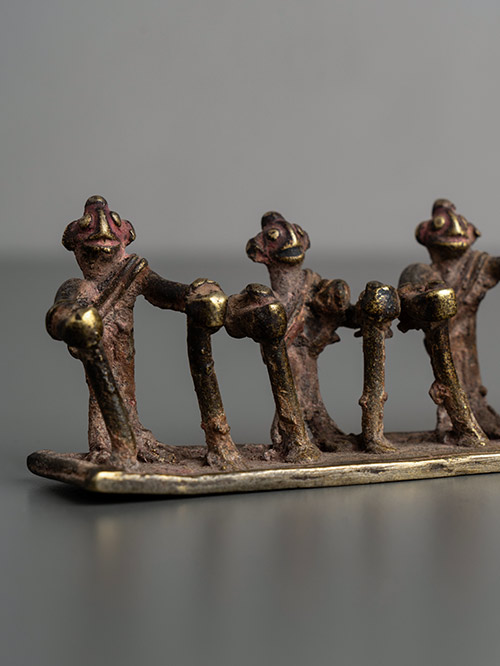
Maharashtra
Brass alloy
This folk bronze depicts a group of munjas (spirits) represented as five men, each holding a pair of sticks and adorned with a yajnopavita (sacred thread). These figures symbolise young men who tragically passed away at the age when they had just begun their studies. To honour their memory and appease their spirits, such figurines are placed on household altars. Through ritual ablution and ceremonies, these ghosts are believed to be transformed into pitra (protective ancestors) who safeguard the family.
Size (cms): 5(H) x 14.5(W) x 3(D)
Size (inches): 2(H) x 5.5(W) x 1(D)
-
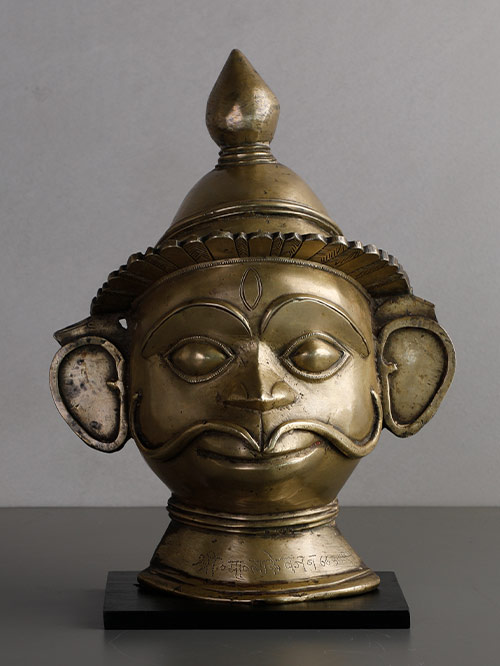
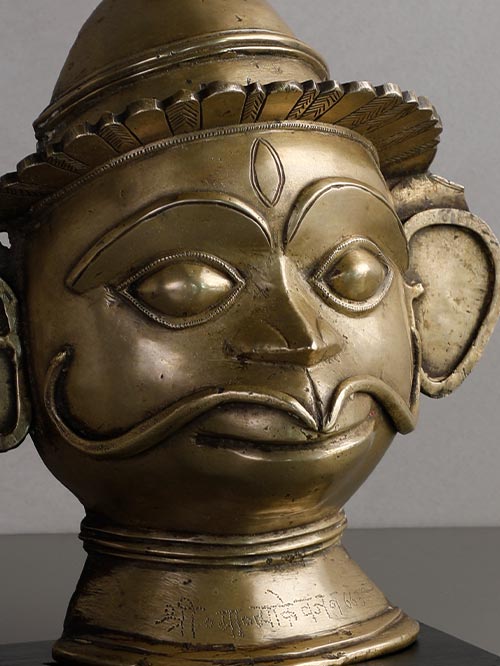
Karnataka (South India)
brass alloy
A striking Hanuman face with a protruding mouth and nose, curving moustache, bulging eyes and forehead tilaka. He wears a necklace and a rimmed and pointed crown.
Mukhavata or facial masks are two-dimensional metal castings of the crowned or turbaned heads of various deities, mostly manifestations of Shiva and Parvati. Included in this group are Khandoba, Mallanna, Gauri and Hanuman and their regional variants who are worshipped under different names.
Hindu devotees believe that when an icon is consecrated and its eyes anointed by the priest, the figure becomes a living god. In household shrines in Maharastra and Karnataka, the deity was considered a privileged house guest and treated accordingly. Images of the god were bathed, clothed, bejeweled and nourished in preparation for puja and darshan. Often elaborate turbans were placed on the head of the mukha-vata and bound by the finest cloths usually in the auspicious deep red colour. In some cases the masks were mounted on a wooden framework and covered with cloths. Sometimes separate metal cast arms and legs were attached to the figure, thus providing a more realistic depiction of the deity.
Size (cms): 35.5(H) x 26(W) x 11.5(D)
Size (inches): 14(H) x 10(W) x 4.5(D)
-
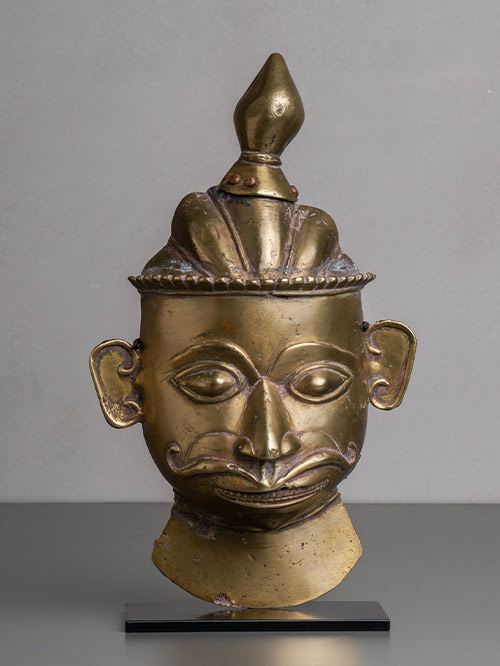
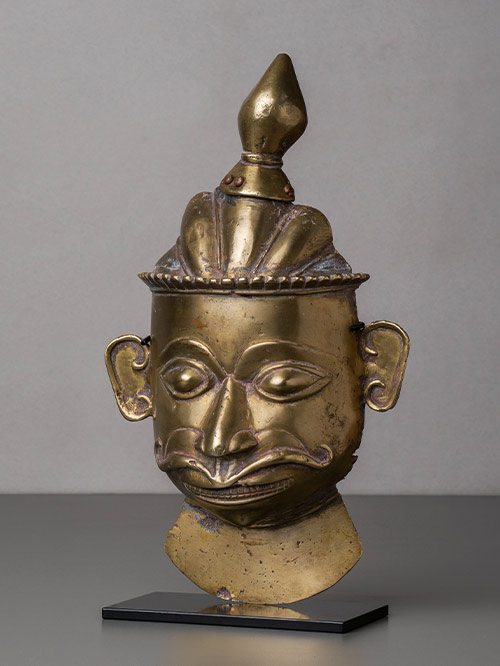
Karnataka (South India)
brass
A striking Hanuman face with a protruding mouth and nose, curving moustache, bulging eyes and forehead tilaka. He wears a necklace and a rimmed and pointed crown.
Mukhavata or facial masks are two-dimensional metal castings of the crowned or turbaned heads of various deities, mostly manifestations of Shiva and Parvati. Included in this group are Khandoba, Mallanna, Gauri and their regional variants who are worshipped under different names.
The story of Hanuman is found in the Ramayana where he is the ubiquitous servant, the epitome of devoted service and loyalty. His search for the heroine Sita, captured by Ravana, illustrates his superhuman powers and zealous performance of the tasks that were given to him.
Size (cms): 32(H) x 19(W) x 11(D)
Size (inches): 12.5(H) x 7.5(W) x 4.5(D)
-
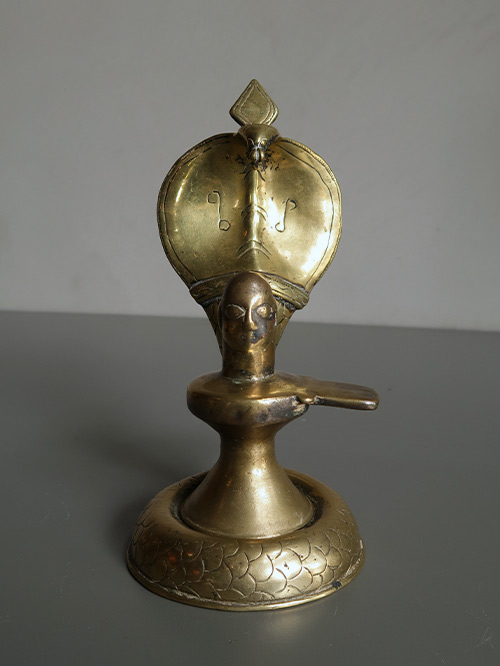
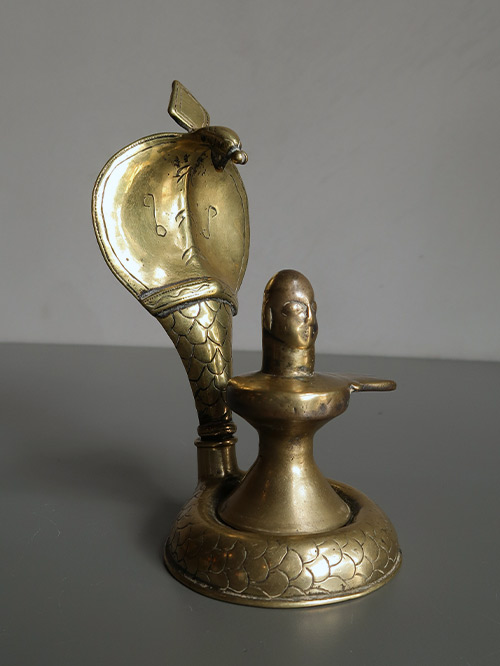
Karnataka (South India)
brass
A finely cast lingam resting on the patterned coils of the serpent Vasuki which forms a canopy overhead.
The Lingam is an abstract or aniconic representation of the Hindu deity Shiva in Shaivism. Lingams are shaped like a pillar with a round top and were made of stone, wood or metal.Eventually, during the Kushan period (1st century to 3rd century CE) in north India, human faces came to be added to the lingams, hence the name mukhalinga. This object marks the presence of the invisible transcendental reality of Shiva, the Hindu god of destruction.
Size (cms): 19(H) x 6.5(W) x 9(D)
Size (inches): 7.5(H) x 2.5(W) x 3.5(D)

































